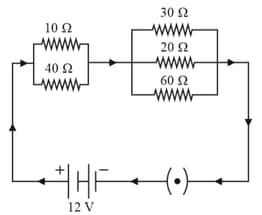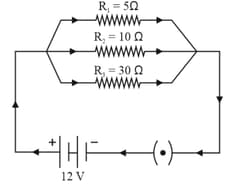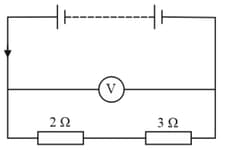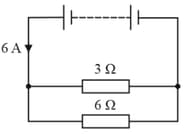An electric heater which is connected to a supply line has two resistance coils and of resistance each. These coils can be used separately (one at a time), in series or in parallel. Calculate the current drawn when: coils and are used in series.

Important Questions on Electricity
In circuit diagram given below five resistances of and are connected as shown to a battery.

Calculate:
(a) the total resistance in the circuit.
(b) the total current is flowing in the circuit.
In the circuit diagram given below, three resistors and of and respectively are connected as shown.

Calculate:
(a) current through each resistor.
(b) total current in the circuit.
(c) total resistance in the circuit.
A potential difference of is applied to two resistors of and connected in series. Calculate:
(a) the combined resistance
(b) the current flowing
(c) the potential difference across the resistor
A potential difference of is applied to two resistors of and connected in parallel. Calculate:
(a) the combined resistance
(b) the current flowing in the main circuit
(c) the current flowing in the resistor.

(a) What is the combined resistance?
(b) What current flows?
(c) What is the potential difference across resistor?
(d) What is the potential difference across resistor?

(a) What is the combined resistance?
(b) What is the potential difference across the combined resistance?
(c) What is the potential difference across the resistor?
(d) What is the current in the resistor?
(e) What is the current in the resistor?
(a) Draw a circuit diagram to represent this. Add an arrow to indicate the direction of conventional current flow in the circuit.
(b) What is the effective resistance of the two resistors?
(c) Calculate the current that flows from the battery.
(d) What is the potential difference across each resistor?
